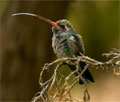 Glittering-bellied Emerald Chlorostilbon aureoventris Credit: Janine White(Size: 59.19 kb) |
As is the case for other birds, the digestive system of hummingbirds is divided into three sections. The first is composed of the oral apparatus, including the beak, mouth, salivary glands, a few taste buds and the tongue. The beak is adapted to the shape of flowers. The tongue alone merits attention. Another section includes the esophagus and gizzard. The gizzard is a kind of extensible pocket where solid food (insects, spiders and pollen) is moistened by mucus. The third section is the stomach. Hummingbirds have a distinctive stomach. The entrance of the first part of the stomach (proventriculus) is particularly close to the exit of the second portion of the stomach (ventriculus) in such a way that the nectar goes through via a shortcut so it is immediately directed to the small intestine where it is absorbed. Only solid particles of food pass through the first and second parts of the stomach.
 Credit: The world of the hummingbird, Robert Burton, Firefly Book, 2001 |
|

